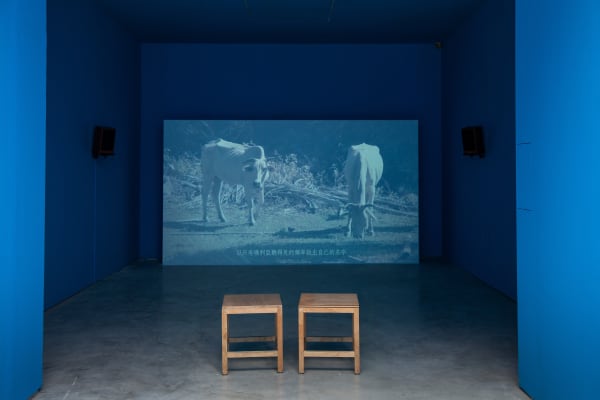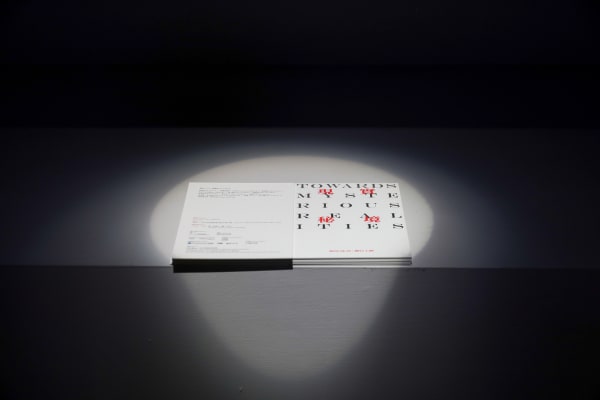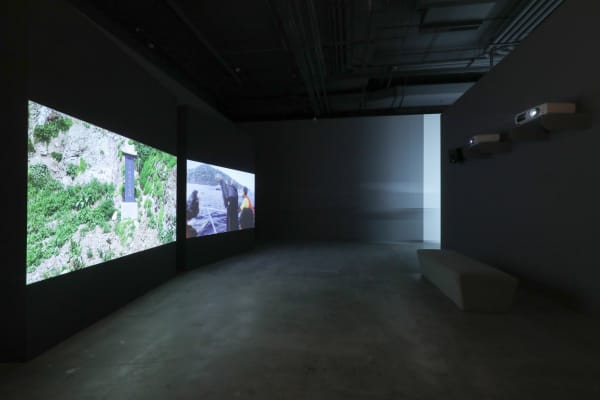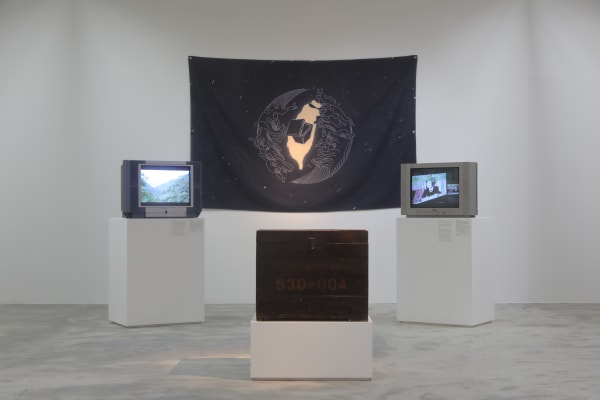Towards Mysterious Realities — Asia, the Cold War and Transitopia: Curated by Amy CHENG
Co-organized by TheCube Project Space and TKG Foundation for Arts & Culture and curated by Amy CHENG, the exhibition Towards Mysterious Realities will take place at TKG+ in Taipei, Taiwan from December 10, 2016 to January 26, 2017.
Towards Mysterious Realities is an exhibition aiming to encourage profound reflection on Asia’s relation to the world. A majority of the thirteen invited artists/collectives are from Asia. They not only add multiple intersected or parallel dimensions to this exhibition through their concerns over specific pieces of history and life experiences, but also attempt to construct or discover the relationships between historical contexts and our day-to-day survival from different perspectives. Specifically speaking, they make observations either from different geographical locations synchronously, or from the same location at different time courses. Both personal experiences and collective consciousness are linked with different historical trajectories charted by the vicissitudinary political and social forces. They may appear as grand as the rise of modern national consciousness or the re-demarcation of Lebensraum, and also as subtle as personal life stories or family history. The clashes of these unique historical trajectories demonstrate a pluralistic, multi-level, and intertwined configuration. On top of that, this exhibition is particularly concerned with the unsettling Cold War experiences throughout the second half of the 20th century, seeking to examine how the previous head-on confrontations over ideologies and values, which have been ignored or consigned to oblivion, lurk in our quotidian existence in a transcendent manner. Furthermore, this exhibition expects such a historical experience stretching back generations to serve as one of major pivotal points for profound reflections ─ rather than to bring about a hasty conclusion ─ wherefrom we can map out alternative routes to grasp and re-narrate realities.
He felt a sudden surge of desperate loneliness, as if the world forsook him. Not until then did he realize that the entire world has been enmeshed in a piece of gargantuan, elaborately structured, and ergo unintelligible apparatus, around which it revolves ceaselessly and undisguisedly.[1]
— Ying-Zhen Chen,
A Day in the Life of a Salaryman, 2001
Towards Mysterious Realities is an exhibition aiming to encourage profound reflection on Asia's relation to the world. A majority of the thirteen invited artists/collectives are from Asia. They not only add multiple intersected or parallel dimensions to this exhibition through their concerns over specific pieces of history and life experiences, but also attempt to construct or discover the relationships between historical contexts and our day-to-day survival from different perspectives. Specifically speaking, they make observations either from different geographical locations synchronously, or from the same location at different time courses. Both personal experiences and collective consciousness are linked with different historical trajectories charted by the vicissitudinary political and social forces. They may appear as grand as the rise of modern national consciousness or the re-demarcation of Lebensraum, and also as subtle as personal life stories or family history. The clashes of these unique historical trajectories demonstrate a pluralistic, multi-level and intertwined configuration. On top of that, this exhibition is particularly concerned with the unsettling Cold War experiences throughout the second half of the 20th century, seeking to examine how the previous head-on confrontations over ideologies and values, which have been ignored or consigned to oblivion, lurk in our quotidian existence in a transcendent manner. Furthermore, this exhibition expects such a historical experience stretching back generations to serve as one of major pivotal points for profound reflections─rather than to bring about a hasty conclusion─wherefrom we can map out alternative routes to grasp and re-narrate realities.
Narrating Realities
However, "narrating realities" might not be as easy a task as it sounds, because "realities" are not simply linear causal chains of events occurred here and now, but mostly the interplay of incidences and experiences in various dimensions revolving around the spatial and temporal axes. In addition to the tangible geographical or physical world, realities contain the mental and spiritual world projected and mirrored by human consciousness. Towards Mysterious Realities is ergo dedicated to develop continuous and interconnected dynamics from the realities in the pluralistic horizons. In this sense, we may construe each artwork in this exhibition as a specific entry point to the realities concerning a given individual or group. The tangible and intangible disconnection and connection among these entry points may thus outline a broader vision of contemporary Asia or even the "sāmānya" (shared essence) of Asian cultures.
To put it another way, Towards Mysterious Realities performs a quasi-phenomenological analysis to find out the subtle effects between consciousness and specific things on the basis of the artists' excavation, transformation and interpretation of their experiences, perceptions and memories. The term "mysterious" in the exhibition title refers not so much to occultism or any exotic destination as to the question about and appreciation of the ambivalence of our quotidian experiences. This is exactly what exemplified in the quotation from Ying-Zhen Chen at the beginning of this article. It implies that this exhibition treats the ideas and consciousness extracted from experiences as a source of continuous "power" or "driving force." History is no longer the concluded past. It affects, runs through, and shapes modern people's life and raison d'être in a subtle yet profound manner.
Taiwanese theater director and cultural critic Mo-Lin Wang remarked that people "often employ the more conceptualized term 'memory' rather than 'history,' a noun with intellectual function─the capability of knowledge production─when they are faced with history (e.g. archaeological evidence, documents and records).[2] In this case, what is the history with the capability of knowledge production? Wang continued, "…it was not until long time after that a historian would alert us to the inauthenticity of a specific piece of history. We have been mired in the history in which the true mingled with the false." As far as Wang is concerned, in the situation that you failed to distinguish the true from the false, what matters is to explore the "subtle mental activities" lurking in history. Wang asked accordingly that "whether the subtleness counts as history if history is construed as a series of mental activities? …We would rather regard history as subtle mental activities than believe it as a meta-viewpoint."[3] Following this methodology, Wang has sought to comprehend his relation to history by delving into the "spiritual world" unfolded with the poetics of narratives woven by works of literature and art. In this sense, the subtleness of these mental activities (i.e. history) may also illustrate the process of self-identity construction if we apply his methodology to the competitive arena of "narrating realities."
Asia's Shared Self
The re-narration of realities in Towards Mysterious Realities revolves around Asia. Why Asia? The "Asia" here, as a medium of self-reflection, is not so much a geographical term as a problematique regarding psychic experiences on history. Between 2013 and 2014, the Hong Kong-based Asia Art Archive undertook a meaningful project titled Mapping Asia which unfolded itself through engaging with different artistic practices, research on Asian contemporary art, and archive collating. As stated in the note from the editors of the project's publication, "[t]he title of the third issue of Field Notes, 'Mapping Asia,' should be enough to induce an immediate state of dizziness at the sheer impossibility of such a proposition… [which] presupposes a mapping process."[4] Asia is a portmanteau concept involving centuries of imagination about "others" and a ceaseless process of self-identity construction. It evolved from Marco Polo's stories of his Asian voyages in the 13th century to the modernization forcibly driven by the imperial expansion and colonialism centuries later. As a result, we can neither give Asia a single rigid definition, nor take the Asian identity for granted.
Then, is there any practical method of forging dialogues and connections among the différance of histories and cultures in Asia? In his article Shamans, Savages and the Wilderness: On the Audibility of Dissent and the Future of Civilizations, Indian scholar Ashis Nandy raised the question as to whether it is still possible for us to contemplate again "the shared self" that transcends nation-states, communities, perhaps even cultures themselves, since we are fettered by the demarcations of modern sovereign states and dominated by the mainstream consumer culture nowadays. Nandy further laid out two criteria: "[o]penness to voice, familiar or strange, may well have to be the first criterion of the shared self… A direct, sharp awareness of man-made suffering, a genuine empirical feel for it, maybe the second."[5] He offered the following example regarding the second criterion: "[p]hilosophers who say that we cannot feel the toothache of others may be right, but we can cognize the ache and use that cognition as the reductio of our conceptual frames."[6] In other words, we may discover many of our parallel or even shared origins and processes through open-minded reflections on the cul-de-sac we encounter in the present era, despite Asia's diverse cultures, beliefs, languages, and historical traumas. It also means that finding out the common (yet veiled) driving forces in modern history that brought us different experiences is perhaps a appropriate departure point for identifying our "shared self."
In recent years, Asia has not only arisen as an urgent geopolitical issue from the wrestling among these historical driving forces once more, but also become the gasoline and electricity by which the engine of capitalist market is powered throughout the process of neo-liberal globalization. It has also served as a wrestling ring for different forces in international politics in this state of affairs, which is by no means a result of historical contingency but a product in response to the times of crisis. Within the first two decades of the post-Cold War era, the globalization of capitalist free market reached an unprecedented level, major powers resumed their fierce competition, China declared its "peaceful rise" as a great power soon after the dawn of the second millennium[7], a global financial crisis was precipitated in 2008, and the United States mapped out "Pivot to Asia" in 2009 as a crucial part of its international political strategy. While these seemingly independent yet actually interlocked events occurred one after another, the "haunting ghost" of the Asian "First island chains," a dominant strategy devised in the highly charged atmosphere during the Cold War, were resurrected from the oblivion with this new wave of political, economic and cultural competitions and confrontations. Through this development, we may conjure up the reason why the re-understanding of and re-discussion on Asia have become aspirations (with the awareness of crisis) or even imperative options or decisions in recent years under the escalating political, economic and cultural tensions. However, we need to stay vigilant about the question as to how Asia, as a complex concept or entity, represents political and economic interests again, so that its cultural productions have been also turned into popular objects of consumption.
To put it simply, the development of modern/contemporary visions of Asia shares an indissoluble bond with Asia's historical experiences. Based on a review of the Cold War and post-Cold War history, the exhibition Towards Mysterious Realities covers a long span from the post-war period to the present. The hidden networks of consciousness in addition to the images outlined and reinforced by states' power, politico-economic interests and ideological wars would be uncovered if we employ cartographic methods to draw a "modern Asian cognitive map." Nonetheless, the ultimate quest of the exhibition is to address the question as to how individuals garner a higher level of insights about their future options from these subtly discernible messages. We live in an era of conflicts and crises. How can we fathom the mystery of what Nandy termed "the shared self" among human beings by reference to the historical relationships built with memories and différance of every stripe? Seeking the answer to this question may be a good start for us to contemplate the increasingly labyrinthine propositions about Asia and the hypothetical scenarios of its future.
Amy Cheng
A curator and writer based in Taipei. She co-founded TheCube Project Space with Jeph Lo in 2010, which serves as an independent art space devoted to the research, production and presentation of contemporary art in Taipei. She has curated various exhibitions including The Heard and the Unheard: Soundscape Taiwan, Taiwan Pavilion at the 54th International Art Exhibition - La Biennale di Venezia (2011), the exhibition series Re-envisioning Society (Taipei, 2011-2013), Shamans and Dissent (Hong Kong, 2013) and Towards Mysterious Realities (2016). She also co-curated these exhibitions: Melancholy in Progress: The 3rd Taiwan International Video Art Exhibition (2012), ALTERing NATIVism -Sound Cultures in Post War Taiwan (2015), Phantom of Civilization (Luxembourg, 2015) and Tell Me a Story - Locality and Narrative (Shanghai, 2016).
Organizer| TheCube Project Space, TKG Foundation for Arts & Culture
Coordination Support| TKG+, TKG+ Projects
Venue Support| Tina Keng Gallery
Media Support| The News Lens, ARTCO, Artist Magazine
Event Support| No Man’s Land
Sponsor| National Culture and Arts Foundation (2015 Production Grants to Independent Curators in Visual Arts)
TheCube Project Space is sponsored by the Ministry of Culture, RC Culture and Arts Foundation, Dr. CHEN Bo-Wen.































